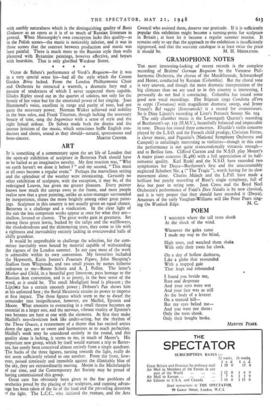ART IT is something of a commentary upon the art
life of London that the open-air exhibition of sculpture in Battersea Park should have to be hailed as an imaginative novelty. My first reaction was, " Why on earth haven't we done it before ? " and my second, "This must at all costs become a regular event." Perhaps the marvellous setting and the splendour of the weather were intoxicating. Certainly no other exhibition of sculpture, with the exception, it may be, of the redesigned Louvre, has given me greater pleasure. Every painter knows how much the canvas owes to the frame, and most people realise now that a great painting, unlike an actor-manager surrounded by inexperience, shines the more brightly among other great paint- ings. Sculpture in this country is not usually given an equal chance. Battersea is a challenge and a vindication. In the clear light of the sun the less competent works appear at once for what they are— shallow, fevered or clumsy. The great works gain in greatness. Set among these green lawns, backed by the tulips and the wallflowers, the rhododendrons and the shimmering trees, they come to life with a rightness and inevitability entirely lacking in overcrowded halls of chilly grandeur.
It would be unprofitable to challenge the selection, for the com- mittee inevitably were bound by material capable of withstanding the rigours of the London summer. In any case most of the work is admirable within its own convention. My favourites included the Hepworth, Karin Jonzen's Fountain Figure, John Skeaping's Stallion from Whipsnade, and two small pieces by names hitherto unknown to me—Benno Schotz and A. J. Pollen. The latter's Mother and Child, in a beautiful grey limestone, pays homage to the Russian ikon convention, and is as pretty, in the best sense of the word, as it could be. The small Modigliani head is pleasant ; the Lipchitz has a certain uncouth power ; Dobson's Pax shows him at his unforced best ; the florid Mestrovic retains its power to impress at first impact. The three figures which seem to me to dwarf the remainder into insignificance, however, are Maillol, Epstein and Moore. What amounts to overacting in a small theatre becomes an essential in a larger one, and the nervous, vibrant vitality of Epstein's two bronzes are here at one with the elements. At first they make Maillol's neo-classicism look like under-acting, but the rhythm of the Three Graces, a restatement of a theme that has excited artists down the ages, are so sweet and harmonious as to reach perfection. Maillol's work may be considered entirely in the round, and this quality alone is lacking, it seems to me, in much of Moore's. His important new group, which by itself would warrant a trip to Batter- sea, has surely been conceived almost entirely from a single quadrant. The backs of the three figures, turning towards the light, really do not seem sufficiently related to one another. From the front, how- ever, poised timelessly and immobile against .the illimitable blue of the sky, they are extraordinarily moving. Moore is the Michelangelo of our time, and the Contemporary Art Society may be proud of having commissioned this group.
Great care has obviously been given to the fine problems of aesthetics posed by the placing of the sculpture, and cunning advan- tage has been taken of the lie of the land and the prevailing direction of the light. The L.C.C., who initiated the ,venture, and the Arts
Council who assisted them, deserve our gratitude. If it is sufficiently popular this exhibition might become a turning-point for sculpture in Britain ; at least let it become a regular summer routine. It remains only to say that the approach to the exhibition is insufficiently signposted, and that the souvenir catalogue is at least twice the price


































 Previous page
Previous page